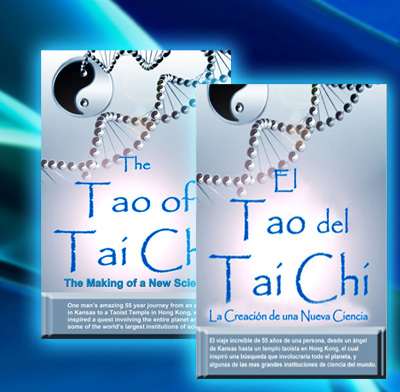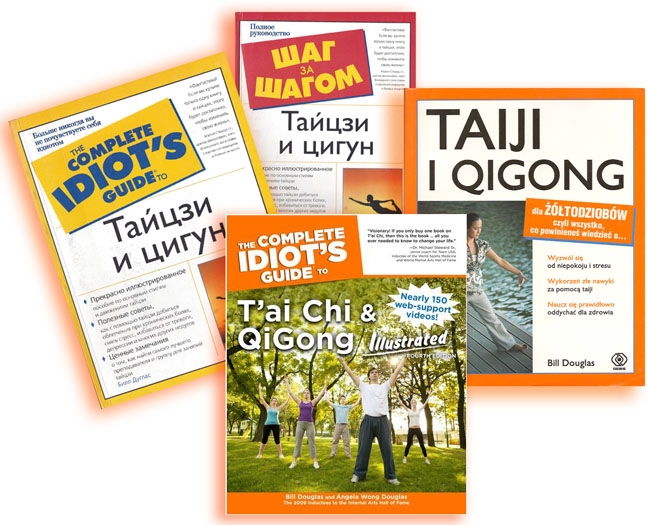aerobic benefit of Tai Chi & qigong
Tai Chi and Qigong Aerobic Benefit
Why Tai Chi is as Good for You as CrossFit
Training!
--
Time
Magazine, April 28, 2017 (Click for article)
GENTLE EFFECTIVE AEROBIC BENEFITS
Tai
Chi Has Similar or Greater Benefits Than Aerobic Exercise for
Fibromyalgia, Study Shows
Tai chi results in similar or greater improvement in fibromyalgia symptoms when compared to aerobic exercise, according to a new study from Tufts University and Brown University.
The mean HR during Qigong and Tai Chi
practice was 91 and 129, respectively. At the peak exercise
and the ventilatory threshold (VeT), the Tai Chi group
displayed the highest oxygen uptake (VO2), O2 pulse and work
rate among the three groups. The Qigong group also showed
higher oxygen uptake and O2 pulse than the control group. At
the same relative exercise intensity, the Qigong group had the
highest tidal volume among the three groups. In conclusion,
Qigong and Tai Chi show a beneficial effect aerobic capacity
in older individuals, but Tai Chi displays a better training
effect than Qigong due to its higher exercise intensity.
However, Qigong can enhance breathing efficiency during
exercise due to the training effect of diaphragmatic
breathing.
-- American Journal of Chinese Medicine, 32,
141-50
CARDIOVASCUALAR BENEFIT. Research has shown that the extremely gentle low impact T'ai Chi exercise can provide the same cardiovascular benefit as moderate impact aerobic exercise. The Harvard Women's Health Watch reported, "studies support Tai Chi [use] for heart-attack and cardiac-bypass patients, to improve cardiorespiratory function and reduce blood pressure."
A total of 29 studies met inclusion
criteria, including 9 randomized controlled trials, 14
nonrandomized studies, and 6 observational trials. The study
subjects included patients with coronary heart disease, heart
failure, CVD, and CVDRF (hypertension, dyslipidemia, impaired
glucose metabolism). Tai Chi interventions ranged from 8 weeks
to 3 years, and the sample size ranged from 5 to 207. Most
studies reported improvement with Tai Chi intervention, such
as reduction in blood pressure and increase in exercise
capacity. In addition, no adverse effects were reported. The
authors concluded that Tai Chi may be a beneficial adjunctive
therapy for patients with CVD and CVDRF.
-- Medscape Today,
from WebMD, 10/26/2010
The Tai Chi group showed 19% higher peak
oxygen uptake in comparison with their sedentary counterparts.
In addition, the Tai Chi practitioners had greater flexibility
and lower percentage of body fat in comparison with their
sedentary counterparts.
-- Archives of Physical Medicine &
Rehabilitation 77(6), 612-616
Tai Chi was observed to be equally
effective as aerobic exercise in reducing both systolic and
diastolic blood pressure.
A growing body of evidence
suggests Tai Chi practice, even over short periods of time,
may improve cardiovascular health. Depending on how it is
practiced, Tai Chi has been characterized as a low to moderate
intensity exercise. Three studies are briefly discussed to
illustrate the types of evidence available to evaluate the
impact that Tai Chi may have on components of cardiovascular
health. Young et al. [4] conducted a well designed, randomized
controlled trial with 62 subjects that compared the effects of
aerobic exercise versus Tai Chi on blood pressure in mildly
hypertensive older adults. Over the 12-week study period, Tai
Chi was observed to be equally effective as aerobic exercise
in reducing both systolic and diastolic blood pressure.
--
Read more at Tufts University's website
Harvard Health Publications
Heart
disease. A 53-person study at National Taiwan University found
that a year of tai chi significantly boosted exercise
capacity, lowered blood pressure, and improved levels of
cholesterol, triglycerides, insulin, and C-reactive protein in
people at high risk for heart disease. The study, which was
published in the September 2008 Journal of Alternative and
Complementary Medicine, found no improvement in a control
group that did not practice tai chi.
Heart failure. In a 30-person pilot
study at Harvard Medical School, 12 weeks of tai chi improved
participants' ability to walk and quality of life. It also
reduced blood levels of B-type natriuretic protein, an
indicator of heart failure. A 150-patient controlled trial is
under way.
Hypertension. In a review of 26
studies in English or Chinese published in Preventive
Cardiology (Spring 2008), Dr. Yeh reported that in 85% of
trials, tai chi lowered blood pressure — with improvements
ranging from 3 to 32 mm Hg in systolic pressure and from 2 to
18 mm Hg in diastolic pressure.
Stroke. In 136 patients who'd had a
stroke at least six months earlier, 12 weeks of tai chi
improved standing balance more than a general exercise program
that entailed breathing, stretching, and mobilizing muscles
and joints involved in sitting and walking. Findings were
published in the January 2009 issue of Neurorehabilitation and
Neural Repair.
Pulmonary Medicine:
Breathing.
Studies have shown better respiratory function in Tai Chi
practitioners compared to those who are sdentary. What's more,
Tai Chi appears to slow the loss of respiratory function in
older adults over time in studies up to five years long.
(Harvard Medical School Guide to Tai Chi. Page 172)
COPD (Projected to be the 3rd leading
cause of death in US by 2020). Conventional pulmonary rehab.
programs focus on aerobic exercise and strength training to
improve exercise capacity, quality of life, and symptoms in
patients with COPD. Tai Chi extends the breathing techniques
taught in pulmonary rehab. by integrating novel elements, such
as progressive relaxation, imagery/visualization, mindfulness
of breathing and overall body sensations, postural training,
and coordinated patterns of breathing and movement. These
additional therapeutic elements make Tai Chi an effective
adjunct to conventional rehabilitation.
Studies: A Harvard study showed that
after 12 weeks the Tai Chi group felt significant improvement
in chronic respiratory symptoms compared to the usual COPD
care group. The Tai Chi group also had slight improvements in
their six-minute walking distance, depression, and shortness
of breath. Harvard is following up with a larger NIH funded
study to compare a Tai Chi group to other meditative
techniques, as well as to a non-exercise education program.
A larger Hong Kong study found a Tai
Chi Qigong group improved key measures of respiratory function
and participated in higher levels of activity when compared to
a walking plus breathing exercise or usual care group. The Tai
Chi group also reported greater improvements in respiratory
health-related quality of life.
Research shows that Tai Chi-like
exercises, including Qigong, may help sustain the gains COPD
patients make after completing pulmonary rehabilitation, which
often is lost after about six months. (Harvard Medical School
Guide to Tai Chi, pages 176 to 178.)
--
Read more at Harvard Health Publications
FIND MUCH MORE RESEARCH AT THE "QIGONG INSTITUTE
DATABASE"
Since 1984, collecting breaking
medical/science research on Qigong, Tai Chi, Yoga, and
Mind-Body Education
Click here
for Qigong Institute Database...
* NOTE: World Tai Chi & Qigong Day advises
consulting your physician before beginning any new exercise,
herbal, diet, or health program. The research listed here is
meant to stimulate a discussion between you and your
physician, health insurance carrier, etc., not as medical
advise. Research and comments provided here are hoped to
stimulate a more robust discussion of powerful natural
mind/body health tools. Popular media, health media, and
government must increase attention to stunning emerging
research, including the UCLA study indicating Tai Chi
participants enjoyed a 50% increase in immune system
resistance to viral infection.
- To learn more about tai chi & qigong medical research,
see the below book,
"the complete idiot's guide to tai chi & qigong,", and also
"Harvard Medical School Guide to Tai Chi," and
"The way of qigong: the art and science of chinese energy healing."
Click to purchase this acclaimed best-selling Tai Chi book, with nearly 150 web-video support videos for the detailed text/illustration instruction as a "gift of health" for loved ones.
A new paradigm in multi-media educational books.
"Visionary! If you only buy one book on T'ai Chi, then this
is the book. This book is all you ever needed to know to
change your life. I have taught T'ai Chi for several decades
myself, yet I have now read Bill's book from cover to cover
seven times, and still get something new from it each time."
– Dr. Michael Steward Sr., D.MA, Ph.D., MA, Senior
Coach for Team USA, Inductee of the World Sports Medicine and
World Martial Arts Hall of Fame
"Sometimes Chinese
culture can be difficult to explain. Sifu Bill Douglas
successfully uses American culture to explain the art of T'ai
Chi Chuan. He simplifies difficult concepts, making them
easier to understand. This book takes the best parts of T'ai
Chi and makes them understandable [to Westerners] without
requiring a grounding in Chinese culture and history."
– Sifu Yijiao Hong, USA All-Tai Chi Grand Champion and USA
Team member; Certified International Coach and Judge,
International Wushu Federation
"Douglas has
achieved for QiGong what Apple did for the computer. He's
brought it to the people … great place to start for beginners.
… Teachers may also find this an excellent manual 'on how to
explain these concepts to the general public…'"
– R.
Poccia,
"The Tao of Tai Chi: The Making of a New Science" (now available in both English and Spanish))

Harvard Medical School Researchers Launch Tai Chi as Therapy Lecture to Commemorate World Tai Chi Day
The new Harvard Medical School Guide to Tai Chi is a powerful
reference book for all tai chi and qigong advocates, teachers,
etc. The Harvard Guide cites WorldTaiChiDay.org's work in
expanding global awareness of tai chi and qigong!
Our
efforts have exposed over ONE BILLION potential viewers/readers
of mass media to Tai Chi and Qigong and its myriad health
benefits, via our annual WTCQD worldwide events.
